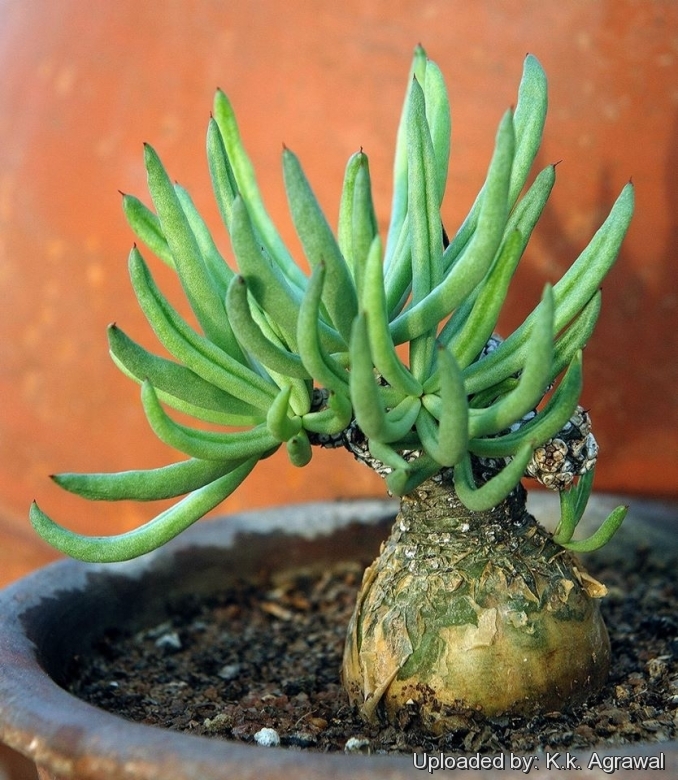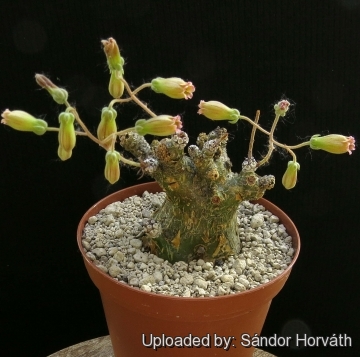Accepted Scientific Name: Tylecodon pearsonii (Schönland) Toelken
Bothalia 12: 380 1978

Cotyledon pearsonii (Tylecodon pearsonii) Photo by: K.k. Agrawal
Origin and Habitat: South Africa (widely distributed from Vanrhynsdorp, through Namaqualand, north and western Cape) to south-western Namibia.
Altitude range: 300 - 1100 metres above sea level.
Habitat and ecology: Tylecodon pearsoniiSN|28087]]SN|28087]] can be found on mountain sides in a winter rainfall region.
Synonyms:
See all synonyms of Tylecodon pearsonii
back
Accepted name in llifle Database:Tylecodon pearsonii (Schönland) ToelkenBothalia 12: 380 1978Synonymy: 3
back
Description: Tylecodon pearsoniiSN|28087]]SN|28087]] is a remarkable stem-succulent shrublet with a grotesquely swollen caudex, with few finger-like shoots covered in leaf-scars. The caudex can reach a diameter of 12 cm and a height of 30 cm. The flowers are whitish, red-striped. In T. pearsonii the flower's buds are pendulous and not erect and spreading as in other Tylecodon species.
Stems: Falling leaves reveal white phyllopodia (protuberances left by fallen leaves). On older stems these formations are replaced by brown, peeling bark.
Leaves: Linear to linear-lanceolate terete with a groove down the upperside, 2-4cm x 2-4mm, soft and pliable, smooth or finely downy, grey-green.
Inflorescence: Scape 6-10cm, the main axis more or less persistent. sparingly branched at the top, bearing a few flowers.
Flowers: Whitish, red-striped, pendent at first but becoming erect as the buds open. Sepals glandular, 5-6 mm long. Corolla-tube urn-shaped, 1.2-1.4 cm long.
Bibliography: Major references and further lectures
1) James Cullen, Sabina G. Knees, H. Suzanne Cubey “The European Garden Flora Flowering Plants: A Manual for the Identification of Plants Cultivated in Europe, Both Out-of-Doors and Under Glass” Cambridge University Press, 11/Aug/2011
2) Botanical Research Institute, Department of Agricultural Technical Services, Republic of South Africa. “The Flowering Plants of Africa” Volumes 50-51, 1988
3) Hermann Jacobsen “A Handbook of Succulent Plants: Ficus to Zygophyllum” volume 2 Blandford Press, 1960
4) Jacobsen “Lexicon of succulent plants” 1974
5) Werner Rauh “The Wonderful World of Succulents: Cultivation and Description of Selected Succulent Plants Other Than Cacti” Smithsonian Institution Press, 1984
6) Gordon Rowley “Caudiciform and Pachycaul Succulents: Pachycauls, Bottle-,Barrel-And Elephant-Trees and Their Kin a Collector's Miscellany” Strawberry Press. June 1st 1987
7) Ernst Jacobus van Jaarsveld, Daryl Lee Koutnik “Cotyledon and Tylecodon” Umdaus Press, 2004
8) Doreen Court “Succulent Flora of Southern Africa” CRC Press, 01/Jun/2000
9) Victor, J.E. & van Jaarsveld, E. 2007. Tylecodon pearsonii (Schönland) Toelken. National Assessment: “Red List of South African Plants” version 2014.1. Accessed on 2014/07/17
 Cotyledon pearsonii (Tylecodon pearsonii) Photo by: Sándor Horváth
Cotyledon pearsonii (Tylecodon pearsonii) Photo by: Sándor HorváthSend a photo of this plant.The gallery now contains thousands of pictures, however it is possible to do even more. We are, of course, seeking photos of species not yet shown in the gallery but not only that, we are also looking for better pictures than those already present.
Read More... Cultivation and Propagation: Although usually grown only by specialist caudiform grower it presents no great difficulty in cultivation. It is a winter grower, dormant in the summer.
Growing rate: This is a very slow growing species.
Soil: Tylecodon pearsoniiSN|28087]]SN|28087]], like all other caudiciforms, requires very well-drained soils. Out-of-Doors prefers sandy soil, sandy loam soil provided the drainage is good. In pot it needs an open medium comprising equal parts of well decomposed compost or finely milled bark, and river or silica sand (or pumice) or a well drained, cactus compost.
Repotting: Re pot every 2/3 years using the above compost with added slow release fertilizer, but fully grown plants can remain in the same position for many years. Plant it with the neck at soil level and grow it in pots with a diameter of at least 25 cm. Give it excellent drainage.
Fertilization: Because they are adapted to poor soil, feeding is not really necessary, but some ash will not do them any harm. On pots fertilize moderately during the growing season with diluted high potassium fertilizer.
Exposure: It is most suitably grown in full exposed areas but it will even grow and bloom in half-sun.
Watering: As it is a deciduous winter-growing plant, it likes moisture from late summer to early spring, and withhold water from late spring to summer (dormancy period). In the growing season water when the roots are almost dry, and reduce watering in winter to once every two weeks.
Hardiness: Winter minimum temperature is 5ºC but better at 8ºC. The leaves easily drop off in cool conditions.
Garden uses: The plants are mostly grown by specialist caudiciform collectors, usually as container subjects.
Warning: The plant is poisonous to stock, causing stomach cramps.
Pest and diseases: It is susceptible to attack by mealy bugs.
Propagation: From seed. Seeds form readily and should be harvested and sown as soon as they can be easily removed from the capsules. The seeds germinate without difficulty. Seeds may take up to two months before the first leaf appears above ground, and a further 10 to 20 years to reach maturity. If it is the intention to plant these seedlings out into a bag or pot, they can be transplanted in their second or third year. Once planted in a permanent position do not dug-up and moved them constantly from one location to the next. A word of caution - do not plant the swollen stems too deep. Ensure the slender neck of the plant is just protruding above the soil with only the root underground. It can also be propagated from cuttings in late Autumn.











